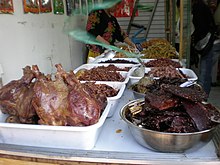Yak meat
Yak meat, the meat from yak , plays only an extremely minor role in the western world. In some Central Asian countries, the yak, which can withstand more extreme climatic conditions and can use the reduced food supply on the Central Asian high plateaus, is a major source of meat. About fifty percent of the meat consumed in the Tibetan and Qinghai highlands comes from the yak.
Features of the meat
Yak meat is similar to beef, but has a slightly lower energy content. 100 grams of yak muscle meat has an average physiological calorific value of approx. 605 kJ (145 kcal ), while comparable beef has an average calorific value of approx. 775 kJ (185 kcal). The meat is coarse-grained and has a small amount of intracellularly stored fat. It is deep red because it is high in myoglobin .
Yak meat is rich in iron and zinc . The fat contains an average of 19 mg carotene per kilogram . This is significantly higher than with beef fat, which only contains 7 mg of carotene. Yak fat is therefore significantly more yellow than beef fat.
use
The meat of wild yaks no longer plays a role today, unlike in the past. House yaks are slaughtered, whereby the meat production is subject to strong fluctuations, since the various yak breeds have so far largely not been bred for meat production. Cattle are occasionally crossed with yaks to increase meat production. The first generation hybrids are usually heavier than the parent generation. Yak meat from young animals is no less tender than that of young cattle. Since yaks are important as milk and wool suppliers in Central Asia and are used as pack animals, many old animals are slaughtered. There is no well-developed meat marketing. Yaks are mainly slaughtered for personal use. The use of yaks as a meat supplier is sometimes subject to religious restrictions.
Central Asian countries of the former Soviet Union
In the successor states of the Soviet Union , there have been some efforts to improve the useful performance of yaks, including through more targeted breeding. Occasionally, herds were fed in winter and young animals were fattened in stables. Meat marketing was the most advanced here.
Mongolia
In Mongolia , there is no very advanced meat marketing. Slaughterhouses only exist in larger cities, so the yak-keeping population groups have little opportunity to sell the meat. The animals are therefore largely slaughtered for personal use only. Meat that is not eaten immediately is often dried in thin strips as so-called borts . Because of the low ambient temperature, this dried meat can often be kept for several years and is easy to transport.
Tibet
The use of meat is partially restricted by the widespread Buddhist belief. The population groups in the highlands, where agriculture is impossible or only possible to a very limited extent due to the climatic conditions, are, however, dependent on meat. The increasing Chinese population in Tibet has also created an increased demand for meat. Devout mountain nomads who slaughter their cattle themselves because they lack professional slaughterers, often give the animals consecrated water before slaughter or light a butter lamp as an offering in front of the house altar. The time of slaughter is usually late autumn or the beginning of winter. Yak meat is occasionally made into sausages. It is also dried and smoked.
Nepal
While beef is not consumed partly for religious reasons, there are partly contradicting interpretations to what extent yak meat and the meat of beef-yak hybrids are affected by these religious regulations. In the high mountain regions of Nepal , where arable farming is only possible to a very limited extent, yak meat definitely plays a major role in the diet. Sherpas do not usually kill their cattle themselves, but leave this task to butchers belonging to other population groups. The meat is often not only eaten fresh, but also dried and smoked.
India and Bhutan
In India , yaks predominantly play a role in the state of Sikkim . This is located in the southern Himalayas between Nepal, Bhutan and China. The use of meat by yaks only plays a subordinate role in Sikkim and Bhutan. However, yak meat is more valued than beef. In India in the 1990s, 10 rupees were paid per kilogram of yak meat , while comparable beef was sold for 7.5 rupees.
See also
supporting documents
literature
- Jürgen Lensch, Peter Schley and Rong-Chang Zhang (eds.): The Yak (Bos grunniens) in Central Asia , Gießener Abhandlungen zur Agrar- und Wirtschaftsforschung der European East, Volume 205, Berlin 1996, ISBN 3-428-08443-8

